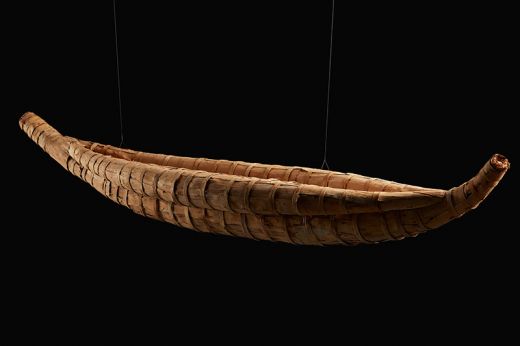
A University of Tasmania online exhibition will celebrate connection to Country and cultural survival while questioning dominant Anglocentric Australian history, 250 years following Captain James Cook’s visit to Australia.
The exhibition program will commence at 3 pm today, Friday, 7 August, with from three of the artists, as well as Professor Ian Mclean, Hugh Ramsay Chair of Australian Art History at the University of Melbourne and Professor Greg Lehman, University of Tasmania Pro Vice-Chancellor, Aboriginal Leadership.
The will go live on Saturday, 22 August, on the date that Cook claimed the east coast of Australia for the British Crown in 1770.
The exhibition will feature 54 artworks, including more than 40 artworks from the University’s Fine Art Collection, such as recent acquisitions The Conquest (2013) by Rew Hanks and Canoe (2013) by Tasmanian Aboriginal Elder Rex Greeno.
Greeno, upon retiring from a 40-year career as a fisherman, turned to constructing traditional Tasmanian Aboriginal canoes which had not been seen in lutruwita/Tasmania since the early 19th century. Canoe is an exquisite scale replica of these unique paperbark watercraft.
“We want to show artworks which are not usually available to a wide audience, and an online exhibition spurred by COVID-19 also enables people to access the exhibition nationally and internationally,” co-curator and University Fine Art Collection Registrar Ms Rachael Rose said.
On loan from artist Julie Gough is her video work Tomalah (2015), filmed on Bruny Island. According to Gough, tomalah means ‘long way’ in ancestral Aboriginal language – referring to the object being a long way from home and us, a long way from the object.
“This work links us to Cook’s erroneous navigation, missing the Tasmanian coastline mapped by Abel Tasman 130 years before and only finding Van Diemen’s Land on his third voyage in 1777,” co-curator Professor Lehman said.
“Against the backdrop of Cook commemorations, Australian artists continue to spotlight unresolved social issues such as Black deaths in custody and emphasise the strength and continuity of Aboriginal culture and the ongoing struggle for justice.”
Available online from Saturday, 22 August, will be a learning resource, including a Welcome to Country filmed on Bruny Island at the site of Cook’s landing, a 360-degree virtual gallery tour and curatorial floor talk, and 3D interactive images of cultural objects in the exhibition.
“The student learning resource will offer insight into the art of European encounters with Indigenous Australians, and the life and death of Captain Cook,” Ms Rose said.
A collaboration with ³Ô¹ÏÍøÕ¾ Science Week will also result in a web resource and activities that explore the science and art of Aboriginal canoe making, including a video presentation by Greeno, available at .
Today’s online event from 3-5 pm will feature a visual introduction to the exhibition by Professor Lehman and a panel discussion and Q&A with:
- Professor Ian Mclean, Hugh Ramsay Chair of Australian Art History, University of Melbourne (panel chair);
- Julie Gough, artist, based in Hobart;
- Rew Hanks, artist, based in Sydney; and
- Tom Nicholson, artist, based in Melbourne.
People can register for the online event at . From 22 August, the exhibition will be accessible via .
The exhibition is presented by the University’s Plimsoll Gallery (currently closed to the public) and Fine Art Collection in collaboration with the Office of the Pro Vice-Chancellor, Aboriginal Leadership.
Image: Rex Greeno, ‘Canoe’, 2013, Tasmanian paperbark, tea tree, string, glue. Photo credit: Rémi Chauvin







